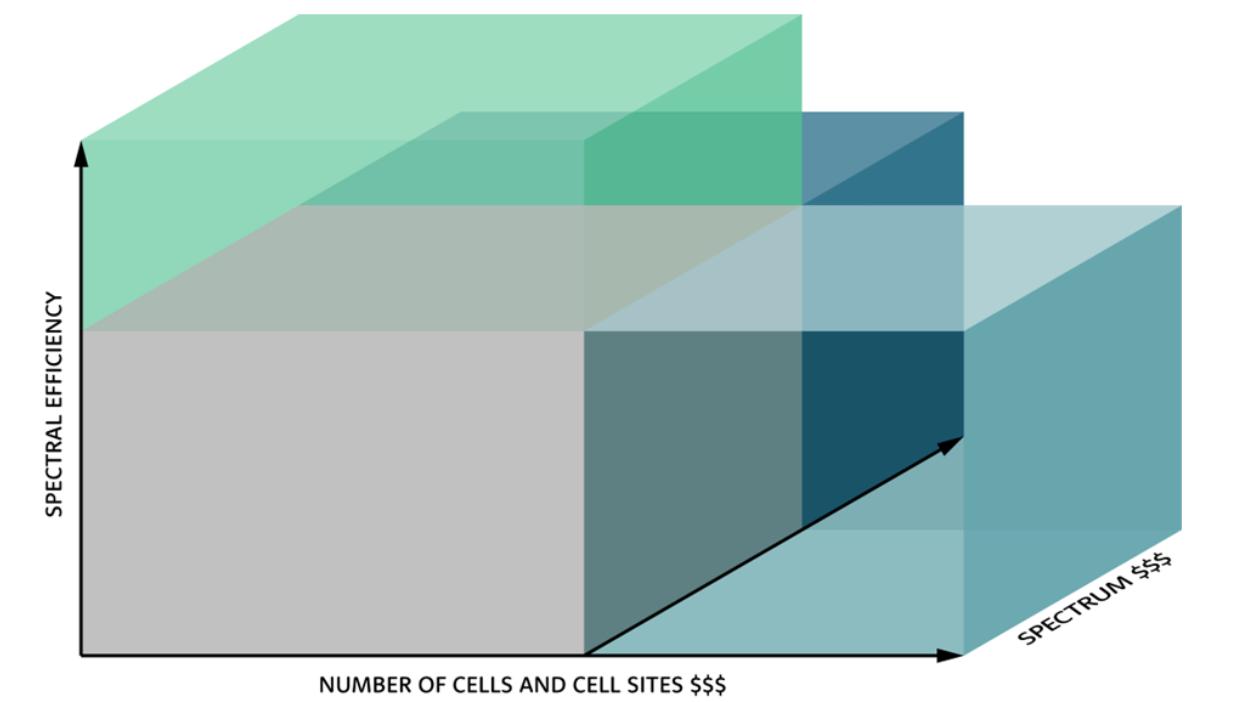Spectral Efficiency
In many countries mobile operators license spectrum to transmit data on a given frequency band. Governments were able to make billions of $ in licensing this spectrum which also helped reduce interference and enable a stable deployment for mobile operators. However for every given frequency band there is limit to the total amount of useful information bits that can be transferred within the licensed band. Due to the cost of licence and the desire to deliver more valuable services, maximising the amount of useful data bits becomes essential to reducing the cost per bit.
Spectral efficiency provides a measure of the bit rate that is transmitted in a given communication channel. It is the net bit rate (useful information rate excluding error-correction codes) or the throughput divided by the radio frequency bandwidth. Spectral Efficiency is measured in bits per second per Hertz (bit/s/Hz).

What is Spectral Efficiency?
The maximum theoretical spectral efficiency of a communication system would be derived from the maximum Capacity of the communication channel, as defined in Shannons theorem (for an explanation see Shannons Theorem )
In wireless cellular networks, the spectral efficiency value is often described as bit/s/Hz per cell, and it measures the quantity of users or services that can be simultaneously supported by a limited bandwidth in a defined geographic area.
The need for high Spectral Efficiency
The capacity of a mobile communication network is the maximum amount of data that can be transmitted over it. It is a function of the amount of spectrum available, the number of cells (or base stations), and the spectral efficiency of each one. (See Fig 1)
The network capacity is a vital part of a mobile operator's business proposition – it defines which services its network can provide and the number of users it can support. Under-provisioning of network capacity leads to congestion, resulting in bad user experience, loss of productivity, and a negative business impact.
The cost of spectrum is high, as is the cost of base stations, and even more importantly acquiring the base station sites themselves and the optical connections to these sites. Together these form the bulk of a mobile operator’s network deployment CAPEX.
Moreover, the size of the operators network also defines the scale of the network OPEX, including support and maintenance, power, site lease costs, etc
There are three options for an operator wanting to increase capacity of a network:
- Purchase more spectrum
- Deploy more cells
- Use higher spectral efficiency cells
The top two options are expensive and unwieldy, whereas the use of higher efficiency cells is much lower cost, and still yields substantial benefits.
The benefits of High Spectral Efficiency
Higher spectral efficiency means greater network capacity, and the service provider can “spend” this extra capacity in a number of ways depending on his business proposition and priorities. For example, he might choose to deliver an improved user experience to offer a premium consumer service. Alternatively, he may prefer to maintain the same level of service but reduce the number of base stations required to offer that service.

Delivering High Spectral Efficiency in 5G applications
The AccelerComm Layer 1 solution can deliver up to 3dB of additional uplink receiver gain.
For 5G, a 3dB improvement in the uplink is a game changer and has a direct correlation to the overall spectral efficiency of the channel, meaning there is more capacity for UEs (User Equipments) to share, both in uplink and downlink. This helps throughput to all UEs, which is important because it means that operators are able to offer their preferred broadband service tier to more UEs, or reduce the spectrum or number of gNodeBs required to offer that service tier. This scenario is relevant both in dense urban areas with high density of UEs, high throughput requirements, and high levels of interference, as well as in suburban and rural areas where distances are longer and UE density is lower.
Whitepaper: The dollars are in the details
This whitepaper, commissioned from Mobile Experts research reveals enhanced LDPC IP can reduce a US operator’s gNodeB requirements by 2,550.
It covers:
-
The factors impacting 5G spectral efficiency and its impact on network performance and capacity
-
The business case for better spectral efficiency and how it can maximize ROI from scarce spectrum assets
-
The steps Operators and Vendors can take to maximize Spectral Efficiency of their 5G network



